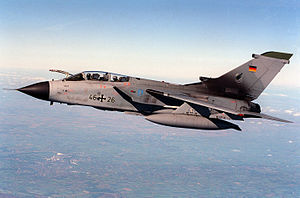Template:Pilgrimsfalk I: Difference between revisions
| Line 30: | Line 30: | ||
In the late 80's and early 90's, after several years conducting training excercises with the much more advanced [[Fliegertruppen des engleanisches Kaiserreiches|Luftstreitkräfte]], officers of the [[Royal Talvistovan Air Force]] realized that the current fighter, the Sparvhok, was woefully outdated compared to the other air forces of Sunalaya. In responses a design contest was held to field options of aircraft to replaced the sparvhok in the role of the RTAF's primary multirole fighter. | In the late 80's and early 90's, after several years conducting training excercises with the much more advanced [[Fliegertruppen des engleanisches Kaiserreiches|Luftstreitkräfte]], officers of the [[Royal Talvistovan Air Force]] realized that the current fighter, the Sparvhok, was woefully outdated compared to the other air forces of Sunalaya. In responses a design contest was held to field options of aircraft to replaced the sparvhok in the role of the RTAF's primary multirole fighter. | ||
Of the 3 finalists chosen, the | Of the 3 finalists chosen, the National Aeronautics' X-702 won out, due to the projected cost and bankruptcy of the 2 other design firms that made the finals. | ||
After continued testing, the X-702, eventually renamed to the Pilgrimsfalk, had it's first flight in | |||
==Operators== | ==Operators== | ||
Revision as of 22:01, 1 July 2019
| Pilgrimsfalk I | |
|---|---|

| |
| A Pilgrimsfalk assigned to the 5th Kämpeskvadron | |
| Role | Multirole Fighter |
| National origin | Talvistova |
| Manufacturer | National Aeronautics |
| First flight | 1986 |
| Introduction | 1993 |
| Status | In service |
| Primary user | RTAF |
| Produced | 1993-2000 |
| Number built | 150 |
| Variants | Pilgrismfalk II |
The Pilgrimsfalk I ("Peregrine Falcon") is a twin-engine, variable-sweep wing multirole combat aircraft. The vehicle was designed to act as the primary multirole fighter aircraft of the RTAF, replacing the outdated Sparvhok ("sparrowhawk"). The Pilgrimsfalk is capable of air-superiority, interceptor, and air-to-surface operations in any weather condition. The aircraft is expected to remain in service until 2025, when it will be fully replaced by the Pilgrimsfalk II.
Development and History
In the late 80's and early 90's, after several years conducting training excercises with the much more advanced Luftstreitkräfte, officers of the Royal Talvistovan Air Force realized that the current fighter, the Sparvhok, was woefully outdated compared to the other air forces of Sunalaya. In responses a design contest was held to field options of aircraft to replaced the sparvhok in the role of the RTAF's primary multirole fighter.
Of the 3 finalists chosen, the National Aeronautics' X-702 won out, due to the projected cost and bankruptcy of the 2 other design firms that made the finals.
After continued testing, the X-702, eventually renamed to the Pilgrimsfalk, had it's first flight in
Operators
Specifications
Specifications
General characteristics
- Crew: 1 (operational aircraft) or 2 (training aircraft)
- Length: 15.96 m (15.96 m)
- Wingspan: 10.95 m (10.95 m)
- Height: 5.28 m (5.28 m)
- Wing area: 51.2 m² (51.2 m²)
- Empty weight: 11,000 kg (11000 kg)
- Loaded weight: 16,000 kg (16,000 kg)
- Max. takeoff weight: 23,500 kg (23,500 kg)
- Fuel capacity: 5000 kg
- Powerplant: 2 × Merzedes-Benz MzB-350 KorenJET afterburning turbofans
- Dry thrust: 60 kN (60 kN) each
- Thrust with afterburner: 90 kN (90 kN) each
Performance
- Maximum speed: Mach 2.4
- Range: 2,900 km ()
- Ferry range: 3,790 km (3790 km) with 3 external drop tanks
- Service ceiling: 19,812 m ()
- Rate of climb: 318 m/s (318m/s)
- Wing loading: 312 kg/m² (63.9 lb/ft²)
- Thrust/weight: 1.15
Armament
- Guns: 1 × 27mm KWF-89 revolver cannon with 150 rounds
- Hardpoints: Total of 13: 8 × under-wing; and 5 × under-fuselage pylon stations; holding in excess of 9000kg of payload and provisions to carry combinations of:
- Missiles:
- Bombs: ***Pb-89 LGB
- Other: Up to 3× drop tanks for ferry flight/extended range/flight time
- Missiles:
Avionics